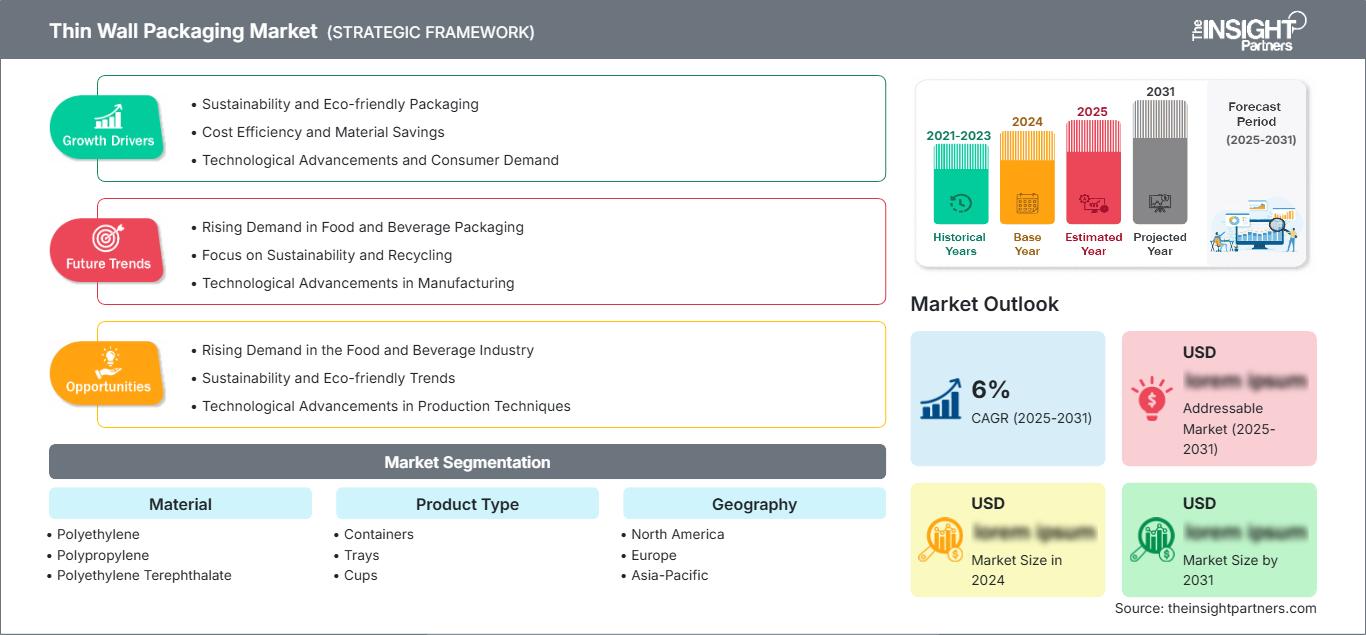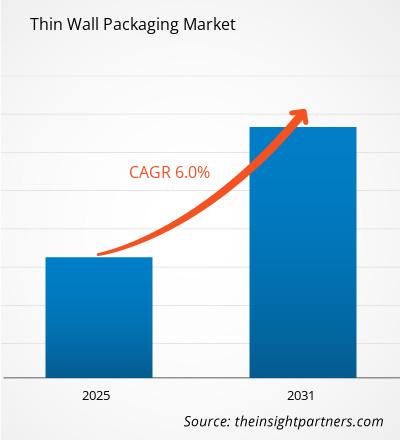Si prevede che il mercato degli imballaggi a parete sottile registrerà un CAGR del 6% dal 2025 al 2031, con una dimensione del mercato in espansione da XX milioni di dollari nel 2024 a XX milioni di dollari entro il 2031.
Il rapporto sul mercato degli imballaggi a parete sottile è segmentato per materiale (polietilene, polipropilene, polietilene tereftalato, polistirene e altri). Il mercato è segmentato in base alla tipologia di prodotto (contenitori, vassoi, tazze, coperchi, vaschette e altri). Il mercato è segmentato in base al processo (termoformatura, stampaggio a iniezione, stampaggio a soffiaggio e altri). Il mercato è segmentato in base all'applicazione [alimenti e bevande (latticini, alimenti pronti, carne e pesce, frutta e verdura, altri), cura della persona e cosmetici, prodotti farmaceutici e altri]. Le dimensioni e le previsioni del mercato a livello globale, regionale e nazionale per tutti i principali segmenti di mercato sono trattate nell'ambito di applicazione. Il rapporto fornisce il valore in USD per l'analisi, i segmenti, le regioni e i paesi sopra indicati. Il rapporto copre le tendenze e le dinamiche di mercato, come fattori trainanti, vincoli e opportunità chiave. Il rapporto include anche un'analisi del panorama industriale e della concorrenza, che include la concentrazione del mercato, l'analisi delle mappe di calore, i principali attori e i recenti sviluppi del mercato.
Scopo del rapporto
Il rapporto "Thin Wall Packaging Market" di The Insight Partners mira a descrivere il panorama attuale e la crescita futura, i principali fattori trainanti, le sfide e le opportunità. Ciò fornirà spunti a vari stakeholder aziendali, come:
- Fornitori/produttori di tecnologia: per comprendere le dinamiche di mercato in evoluzione e conoscere le potenziali opportunità di crescita, consentendo loro di prendere decisioni strategiche informate.
- Investitori: per condurre un'analisi completa delle tendenze in merito al tasso di crescita del mercato, alle proiezioni finanziarie del mercato e alle opportunità esistenti lungo la catena del valore.
- Organismi di regolamentazione: per regolamentare le politiche e le attività di controllo nel mercato con l'obiettivo di ridurre al minimo gli abusi, preservare la fiducia degli investitori e sostenere l'integrità e la stabilità del mercato.
Materiale di segmentazione del mercato degli imballaggi a parete sottile
- Polietilene
- Polipropilene
- Polietilene tereftalato
- Polistirene
Tipo di prodotto
- Contenitori
- Vassoi
- Tazze
- Coperchi
- Vaschette
Potrai personalizzare gratuitamente qualsiasi rapporto, comprese parti di questo rapporto, o analisi a livello di paese, pacchetto dati Excel, oltre a usufruire di grandi offerte e sconti per start-up e università
Mercato degli imballaggi a parete sottile: Approfondimenti strategici

-
Ottieni le principali tendenze chiave del mercato di questo rapporto.Questo campione GRATUITO includerà l'analisi dei dati, che vanno dalle tendenze di mercato alle stime e alle previsioni.
Fattori di crescita del mercato degli imballaggi a parete sottile
- Sostenibilità e imballaggi ecocompatibili: consumatori e produttori stanno dando priorità a soluzioni di imballaggio sostenibili. Gli imballaggi a parete sottile riducono l'utilizzo di materiali, contribuendo a ridurre gli sprechi e l'impronta di carbonio. Questo approccio ecocompatibile è in linea con le tendenze globali volte a ridurre i rifiuti di imballaggio e ad aumentare i tassi di riciclo.
- Efficienza dei costi e risparmio di materiali: gli imballaggi a parete sottile utilizzano meno materiali rispetto ai metodi di imballaggio tradizionali, riducendo i costi di produzione. Migliorano inoltre l'efficienza operativa consentendo di confezionare più prodotti nello stesso spazio. Questa riduzione dei costi dei materiali li rende interessanti per settori come quello alimentare e delle bevande, farmaceutico e dei beni di consumo.
- Progressi tecnologici e domanda dei consumatori: le innovazioni nello stampaggio a iniezione e in altri processi di produzione hanno reso più semplice ed economica la produzione di imballaggi a parete sottile. Inoltre, la crescente domanda di prodotti pratici, leggeri e facili da maneggiare da parte dei consumatori sta spingendo il mercato degli imballaggi a parete sottile in diversi settori.
Tendenze future del mercato degli imballaggi a parete sottile
- Crescente domanda di imballaggi per alimenti e bevande: l'industria alimentare e delle bevande è uno dei maggiori consumatori di imballaggi a parete sottile. I contenitori a parete sottile sono comunemente utilizzati per prodotti come latticini, snack, insalate e bevande, poiché offrono durata, leggerezza e una migliore attrattiva sugli scaffali. Con la crescente preferenza dei consumatori per opzioni alimentari pratiche e pronte al consumo, la domanda di soluzioni di imballaggio a parete sottile è in crescita in questo settore.
- Focus su sostenibilità e riciclo: con l'aumento delle preoccupazioni ambientali, il mercato degli imballaggi a parete sottile sta assistendo a una transizione verso materiali sostenibili. I produttori si stanno concentrando sempre più sull'utilizzo di plastiche riciclabili, biodegradabili ed ecologiche come PET e PP per soddisfare la domanda dei consumatori di soluzioni di imballaggio più ecologiche. La spinta alla riduzione dei rifiuti di plastica e all'adozione dei principi dell'economia circolare sta incoraggiando l'innovazione nelle tecnologie dei materiali, portando allo sviluppo di imballaggi a parete sottile più sostenibili.
- Progressi tecnologici nella produzione: l'adozione di tecnologie di produzione avanzate, come lo stampaggio a iniezione e la termoformatura, sta guidando la crescita del mercato degli imballaggi a parete sottile. Queste tecnologie consentono processi di produzione più efficienti, una maggiore precisione nella progettazione e una riduzione degli sprechi di materiale. Con il continuo miglioramento di queste tecnologie, gli imballaggi a parete sottile diventano più convenienti e personalizzabili, rendendoli un'opzione interessante per una varietà di settori, tra cui beni di consumo, assistenza sanitaria e cura della persona.
Opportunità di mercato per gli imballaggi a parete sottile
- Crescente domanda nel settore alimentare e delle bevande: gli imballaggi a parete sottile sono ampiamente utilizzati nel settore alimentare e delle bevande grazie alla loro capacità di ridurre l'utilizzo di materiale pur mantenendo resistenza e durata. Con la crescente domanda dei consumatori di soluzioni di imballaggio pratiche, leggere e sostenibili, in particolare per pasti pronti, bevande e snack, il mercato degli imballaggi a parete sottile è in espansione. Questo tipo di imballaggio contribuisce a ridurre i costi di spedizione, lo spazio di stoccaggio e gli sprechi di imballaggio, rendendolo una soluzione interessante per i produttori alimentari.
- Sostenibilità e tendenze ecologiche: con l'aumento delle preoccupazioni ambientali, si sta diffondendo l'utilizzo di materiali riciclabili, biodegradabili ed energeticamente efficienti negli imballaggi. Gli imballaggi a parete sottile, in particolare in plastica, vengono sviluppati utilizzando materiali riciclabili e leggeri, che soddisfano le richieste dei consumatori e delle normative per imballaggi più sostenibili. La spinta verso una riduzione dell'impronta di carbonio e soluzioni di imballaggio ecocompatibili sta guidando l'adozione di imballaggi a parete sottile in diversi settori, tra cui la cura della persona e i prodotti farmaceutici.
- Progressi tecnologici nelle tecniche di produzione: le innovazioni nelle tecnologie di stampaggio a iniezione e termoformatura consentono ai produttori di produrre imballaggi a parete sottile di alta qualità a costi inferiori. Questi progressi migliorano l'efficienza dei materiali, riducono gli sprechi e aumentano la flessibilità nella progettazione del prodotto. Inoltre, lo sviluppo di nuovi materiali che offrono migliori proprietà barriera e integrità strutturale sta ampliando le applicazioni degli imballaggi a parete sottile in settori come la salute e la cosmetica.
Mercato degli imballaggi a parete sottile
Le tendenze regionali e i fattori che influenzano il mercato degli imballaggi a parete sottile durante il periodo di previsione sono stati ampiamente spiegati dagli analisti di The Insight Partners. Questa sezione illustra anche i segmenti e la geografia del mercato degli imballaggi a parete sottile in Nord America, Europa, Asia-Pacifico, Medio Oriente e Africa, America meridionale e centrale.
Ambito del rapporto sul mercato degli imballaggi a parete sottile
| Attributo del rapporto | Dettagli |
|---|---|
| Dimensioni del mercato in 2024 | US$ XX million |
| Dimensioni del mercato per 2031 | US$ XX Million |
| CAGR globale (2025 - 2031) | 6% |
| Dati storici | 2021-2023 |
| Periodo di previsione | 2025-2031 |
| Segmenti coperti |
By Materiale
|
| Regioni e paesi coperti |
Nord America
|
| Leader di mercato e profili aziendali chiave |
|
Densità degli operatori del mercato degli imballaggi a parete sottile: comprendere il suo impatto sulle dinamiche aziendali
Il mercato degli imballaggi a parete sottile è in rapida crescita, trainato dalla crescente domanda degli utenti finali, dovuta a fattori quali l'evoluzione delle preferenze dei consumatori, i progressi tecnologici e una maggiore consapevolezza dei vantaggi del prodotto. Con l'aumento della domanda, le aziende stanno ampliando la propria offerta, innovando per soddisfare le esigenze dei consumatori e sfruttando le tendenze emergenti, alimentando ulteriormente la crescita del mercato.

- Ottieni il Mercato degli imballaggi a parete sottile Panoramica dei principali attori chiave
Punti di forza
- Copertura completa: il rapporto analizza in modo esaustivo prodotti, servizi, tipologie e utenti finali del mercato degli imballaggi a parete sottile, offrendo una panoramica olistica.
- Analisi degli esperti: il rapporto è redatto sulla base della conoscenza approfondita di esperti e analisti del settore.
- Informazioni aggiornate: il rapporto garantisce la pertinenza aziendale grazie alla copertura di informazioni e dati recenti.
- Opzioni di personalizzazione: questo rapporto può essere personalizzato per soddisfare le esigenze specifiche del cliente e adattarsi in modo appropriato alle strategie aziendali.
Il rapporto di ricerca sul mercato degli imballaggi a parete sottile può quindi contribuire a guidare il percorso di decodificazione e comprensione dello scenario del settore e delle prospettive di crescita. Sebbene possano esserci alcune preoccupazioni valide, i vantaggi complessivi di questo rapporto tendono a superare gli svantaggi.
- Analisi storica (2 anni), anno base, previsione (7 anni) con CAGR
- Analisi PEST e SWOT
- Valore/volume delle dimensioni del mercato - Globale, Regionale, Nazionale
- Industria e panorama competitivo
- Set di dati Excel
Report recenti
Testimonianze
Motivo dell'acquisto
- Processo decisionale informato
- Comprensione delle dinamiche di mercato
- Analisi competitiva
- Analisi dei clienti
- Previsioni di mercato
- Mitigazione del rischio
- Pianificazione strategica
- Giustificazione degli investimenti
- Identificazione dei mercati emergenti
- Miglioramento delle strategie di marketing
- Aumento dell'efficienza operativa
- Allineamento alle tendenze normative






















 Ottieni un campione gratuito per - Mercato degli imballaggi a parete sottile
Ottieni un campione gratuito per - Mercato degli imballaggi a parete sottile